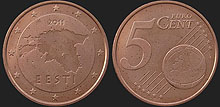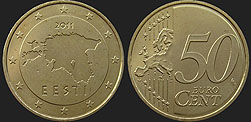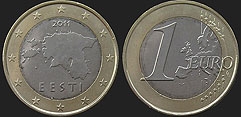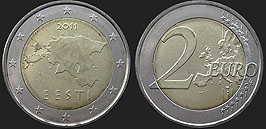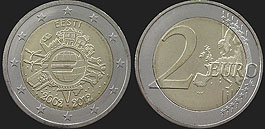ESTONIA (from 2011) - Estonian euro coins [EUR]
1 euro = 100 euro cent
The preparations for the monetary union started in 1991 in Maastricht. In December 1995 in Madrid the name of the new currency was chosen. On January 1st, 1999 Euro [EUR] became an official (although virtual) currency in 11 countries of the European Union (Austria, Belgium, Finland, France, Germany, Ireland, Italy, Luxembourg, the Netherlands, Portugal and Spain). In 2001 Greece also joined the system. The first coins were minted already in 1999, but real money entered circulation only on January 1, 2002. The Eurozone was extended six times: in 2007 (Slovenia), 2008 (Cyprus and Malta), 2009 (Slovakia), 2011 (Estonia), 2014 (Latvia) and 2015 (Lithuania). Thus 19 countries belong to the eurozone today. Euro coins are also being issued by four small countries, which do not belong to the EU, but signed a special agreement with the EU: Andorra, Monaco, San Marino, and Vatican. Euro is the official currency also in Montenegro, Kosovo, and French overseas regions. About 340 millions of people use Euro everyday.
The common side, identical for all of the Euro issuers was chosen in a graphic competition won by Luc Luycx. On June 7, 2005 it was decided to change the design of the common side of euro coins. Coins with face values 10, 20 and 50 cents as well as 1 and 2 euros issued after January 1, 2007 show a full map of Europe without political borders. Coins issued by Italy (including San Marino and Vatican), Austria and Portugal implemented the change only for coins issued in 2008. By the decision of the European Central Bank any euro coin issued after January 1, 2009 must bear the new reverse. Eurozone members may choose any motif for their national side as long as it contains a ring of twelve stars at the edge and the name or symbol of the issuing country.
National side of all Estonian euro coins is represented by one theme - a contour map of the republic and 12 stars of the European Union along the edge. Designs of Estonian national side of euro coins were selected in an open competition in 2004. From 134 projects ten best were qualified for the final telephone voting. Estonians chose the project "Hara 2" by Lembit Lõhmus, who collected 27.5% (12 428) of all 45 453 votes. In the bottom of the page we publish the ten final projects of Estonian euro coins. [Source Bank of Estonia (Eesti Pank)]. Euro currency replaced Estonian kroon [EEK] on January 1, 2011. The parity was set at 1 [EUR] = 15.6466 [EEK]. Coins and banknotes of the Estonian kroon can be exchanged into euro without any time limits at the central bank.
Final ten designs of the competition for Estonian obverse of the euro coins together with voting results.
place: 1 / design: Hara 2 / designer: Lembit Lõhmus / digit of votes: 12 482 (27,46%)

place: 2 / design: Järjepidevus / designer: Tiit Jürna / digit of votes: 7 477 (16,45%)

place: 3 / design: In Corpore / designer: Jaan Meristo / digit of votes: 7 284 (16,03%)

place: 4 / design: Tomsoon 5791 / designer: Taavi Torim / digit of votes: 6 219 (13,68%)

place: 5 / design: Eesti keel / designer: Jaak Peep, Villem Valme / digit of votes: 5 997 (13,19%)

place: 6 / design: 261948 / designer: Villu Järmut, Mai Järmut / digit of votes: 3 036 (6,68%)

place: 7 / design: Linnutee / designer: Tiit Jürna / digit of votes: 1 323 (2,91%)

place: 8 / design: Leopardid-2 / designer: Jaano Ester / digit of votes: 759 (1,67%)

place: 9 / design: Nova / designer: Rene Haljasmäe / digit of votes: 498 (1,10%)

place: 10 / design: Lill rukkis / designer: Margus Kadarik / digit of votes: 378 (0,83%)

coins catalogue :: katalog monet :: münzkatalog :: catalogue de monnaies :: catálogo de monedas :: catalogo monete :: каталог монет :: κέρματα κατάλογος :: COINZ.eu
© 2010-2025 :: Adam Kubicki :: COINZ.eu :: All rights reserved.


